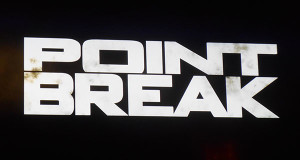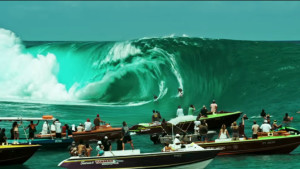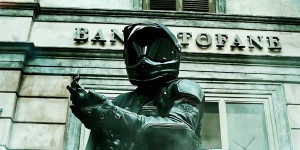As you might have heard, and seen with the Point Break trailer, the classic film that starred Keanu Reeves and Patrick Swayze is being remade. We recently saw some impressive footages and full scenes from Point Break 2015 and caught up with director Ericson Core to gain some insight into the key to his version of a truly modern film that still pays tribute to the trailblazing original. More on the footage we saw in the coming days…
But first, we have to start with why even attempt to redo a class in the first place?
“Point Break is a very classic tale, in terms of the relationship between Utah and Bodhi. It’s a chance to see that connection between two men on a deeper level, which we don’t get to see in films very much. Bodhi’s spirit is one that recognizes in Utah that darker side and that edge that he has. He sees someone that he can bring into his own family and save him, in a way,” Core said.
“For Utah, it’s a question of whether he can move that far in the direction of Bodhi, as much as he is pulled to that world and knows it well. It’s about whether his compass can point to his own true north, instead of Bodhi’s.”
Whereas in the first film it was mostly about surfing (and the occasional skydiving moments), this time out all sorts of extreme sports are represented, including base jumping. To capture that and keep his promise that there would be no CG-green screen used, was a paramount challenge for the director, who incidentally served as choreographer to keep that vision tight, explosive and jaw-dropping.
“The reason why most people shoot on green screen stages is that it’s much easier, but there’s a different feel to it. As entertaining as all those films are, there was something about the authenticity of the thoughts, and the extreme nature behind it that we wanted to capture,” Core said.
Authenticity was the whole ballgame for Core and his team. So he enlisted the help of Jeb Corliss, one of the film’s consultants. Corliss is a legend in the extreme sports world for many things, but especially base bumping. Working with Corliss, Core and his filmmaking team embarked on a filmmaking journey that he promises is unlike any we’ve ever seen on the big screen.
“It was important to make it authentic. We wanted to do it for real. When I approached actors, and certainly the extreme athletes, the idea was that we were going to pull no punches. We didn’t want to use CG and push them beyond the capabilities of what’s natural because they’re so extraordinary in their own way. It made it much more challenging to film,” Core said.
Because of that, the shoot crossed 11 countries on four continents – all to ensure that Point Break 2015 not just embodied the extreme sports lifestyle, but actually went to the extreme in all ways possible. “A lot of those locations were picked by the athletes. The athletes were not just stunt people in this, but they were everything. They were location scouts. They were collaborators,” Core said.
The helmer also credited his stars for not only stepping into iconic roles shoes, but giving more than a solid performance to their roles as Johnny Utah and Bodhi. “Luke Bracey, who did an extraordinary job playing Utah, and Edgar Ramirez, who did such an amazing job playing Bodhi and giving such life and humanity to that character — there’s more than that that played Utah and Bodhi. It was a collective and ensemble cast that made it all together. It was wonderful, but it certainly made it difficult to shoot.”
As the Point Break posters show off, this is a film that took the premise of the first film – surfing-loving athletes who rob banks – and amped it up, both in terms of the sports they participate in but also what they do in terms of their crimes. Bodhi is leading a crime ring that are true Robin Hoods. They give to the poor, all while attempting to tackle some of the world’s most un-doable extreme sport pinnacles.
Core reported that the Point Break crew and cast truly bonded more than any experience he’s ever had on a film set. One can see why when he detailed how they went about their business.
“It was less of a classic film production and much more of an expedition for all of us. As a result, it was an expedition mentality. We all stayed in tents in Angel Falls. We all hauled gear up the mountains together. We used helicopters to transport ourselves. We were always on ropes. We were up in ice and we were underwater. There was a lot of danger involved, and I give everyone credit for that,” Core said.
“We allowed the athletes the time it took to jump, climb or ski down the mountain when the avalanche danger, the winds and the conditions were appropriate. It was an incredible risk for all of us. The actors, who are incredible craftspeople, were willing to be strapped to the top of mountains to learn to climb, or to be in the water to do scenes underwater with sharks in the background. There was tremendous risk, but the rewards always outweighed that.”
Core was beyond grateful for the involvement of extreme sports legend and the film’s main consultant for many of its biggest stuns, Corliss. The sports icon’s DNA flow through both the 2015 version of Bodhi and Utah:
What all involved seek to do with this reimagining of a classic is simultaneously take it to its core and also push its envelope.
“These guys look to live fully outside of the realms of what we do — Point Break had that spirit in it. Bodhi talked about trying to do something outside of the bounds of what he considered commerce slavery, or the way we all live 9 to 5 lives and then die,” Core said.
“Each of these guys have such respect for the natural landscape and the beauty of nature that’s around them that that became the premise for much of the film. It was necessary for Bodhi, in this film, to champion that sense of nature, what’s wrong in the world, and how to make it better for the limited time that we’re here. Jeb was the inspiration for a lot of that. A great deal of who Bodhi is in the film is Jeb. The earlier version of Jeb, in his earlier life, is Utah.”
Now that you’ve heard all of Core’s and the Point Break team’s triumph, let’s let the visionary explain why he, at first, did not want anything to do with a redo, and what turned him around.
“The original Point Break is something that I’m a big fan of, and Kathryn Bigelow’s work is something that I’m a giant fan of. We all love it, and it influenced many of us, especially a lot of the athletes that are doing such extraordinary sports outside of the realm of what was possible in 1991,” Core said.
“When I heard about the title Point Break, I said, ‘I absolutely don’t want to remake that.’ At the same time, there was something that I wanted to re-imagine about it, which was the overall story of Johnny Utah and Bodhi and the concepts that were there, and bring it into our time with the socio-environmental issues that are going on today. I live in Venice Beach, where the original story was told. I love that story. It’s very much about the Southern California lifestyle. We wanted to expand beyond that, both in terms of actors that were more international and much more on a world stage.”
Point Break storms into theaters on Christmas Day.





